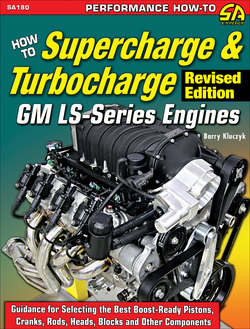Читать книгу How to Supercharge & Turbocharge GM LS-Series Engines - Revised Edition - Barry Kluczyk - Страница 7
ОглавлениеINTRODUCTION
A longtime cliché of the automotive world is the phrase “they don’t build ’em like they used to.” When it comes to the performance capability of the General Motors Gen III/Gen IV engines (commonly known as “LS” engines), that old adage couldn’t be truer—but not in the traditional sense.
The LS engines aren’t built like the old small-blocks, and that’s a good thing. They’ve proven to be very durable and, with their exceptional airflow capabilities, they are capable of tremendous power with comparatively little work. Add a supercharger or turbo system to one of these compact powerhouses and the dyno numbers go through the roof. In fact, the only factor that holds back an LS engine from making astronomical horsepower is the amount of boost that can be safely shoved through it.
I first encountered the LS engine when the rest of the performance public did in the late 1990s. I was shooting stories at a variety of tuning shops and was, frankly, suspicious of the chassis dyno numbers that were being generated by LS1-powered F-Body cars and Corvettes with bolt-on superchargers. Compared to what the previous GM LT1 engines produced and the amount of time and money the Mustang guys were spending to get power out of their 4.6-liter pony cars, the ease at which 500 rear-wheel horsepower was spitting out of the LS-powered vehicles raised more than a few eyebrows. But, as time progressed and GM increased the displacement and performance range of its well-engineered new engine family, big power has become the norm. In fact, street cars pushing 900 hp and more are not hard to find.
Of course, there’s more than one key required to unlock such supercharged performance. The high-flow attributes of the cylinder heads are tailor-made for big power, but it wouldn’t be possible without easily adjustable factory controllers that enable tuning that are the envy of the Mustang and Hemi camps. The controllers, however, are mostly limited to the fuel they can direct into the engine and, in most cases, that ceiling is around the 1,000-hp level. After that, special injector requirements typically mean a stand-alone aftermarket controller that can handle them. But even then, the engine can still be tuned for streetable, pump-gas drivability.
This book outlines the basics of supercharging and turbocharging, as they’re applied to LS engines. It doesn’t suggest either method of forced induction is better than the other but points out the performance differences, installation challenges, and cost implications between them. There are also great tips for building an engine to support higher-boost combinations.
Whether you’re looking for a simple bolt-on blower kit on an otherwise-stock fifth-generation Camaro or a custom-fabricated twin-turbo system for a Corvette Z06, you’ll find plenty of ideas to ponder within these pages. And you’ll see everything from a $46,000 turbo-kit installation to a homemade turbo system built with cast-off and salvage-yard parts.
If you’re new to the performance world or, more specifically, the corner of it that involves forced induction, do yourself a favor and start browsing the online message boards and forums for ideas, and ask around for recommendations on knowledgeable and reputable tuning shops. Before you spend what will minimally be several thousand dollars on a blower or turbo system for your vehicle(s), you’ll want to know unequivocally that it’s going to deliver the performance you’re seeking.
There’s another old automotive saying: “Speed costs money; how fast do you want to go?” I believe that can be rewritten for the LS engine this way: Horsepower requires boost; how much can you afford?
Whatever your answer, a little forethought and some careful planning will ensure you’ll come away satisfied when that boost-gauge needle swings into positive manifold pressure territory.
A Note about GM “LT” Engines
Although architecturally similar to the LS family of engines, the GM Gen V “LT” engines are not covered in this book. At the time this updated edition was published, aftermarket forced-induction support was mostly limited to bolt-on supercharger kits for popular applications such as the Camaro, the Corvette, and full-size trucks. And while many of the same general theories apply to LT engines, tuning support for them was also somewhat limited at the time of this writing. For these reasons, the author’s focus is strictly on the LS-series.
